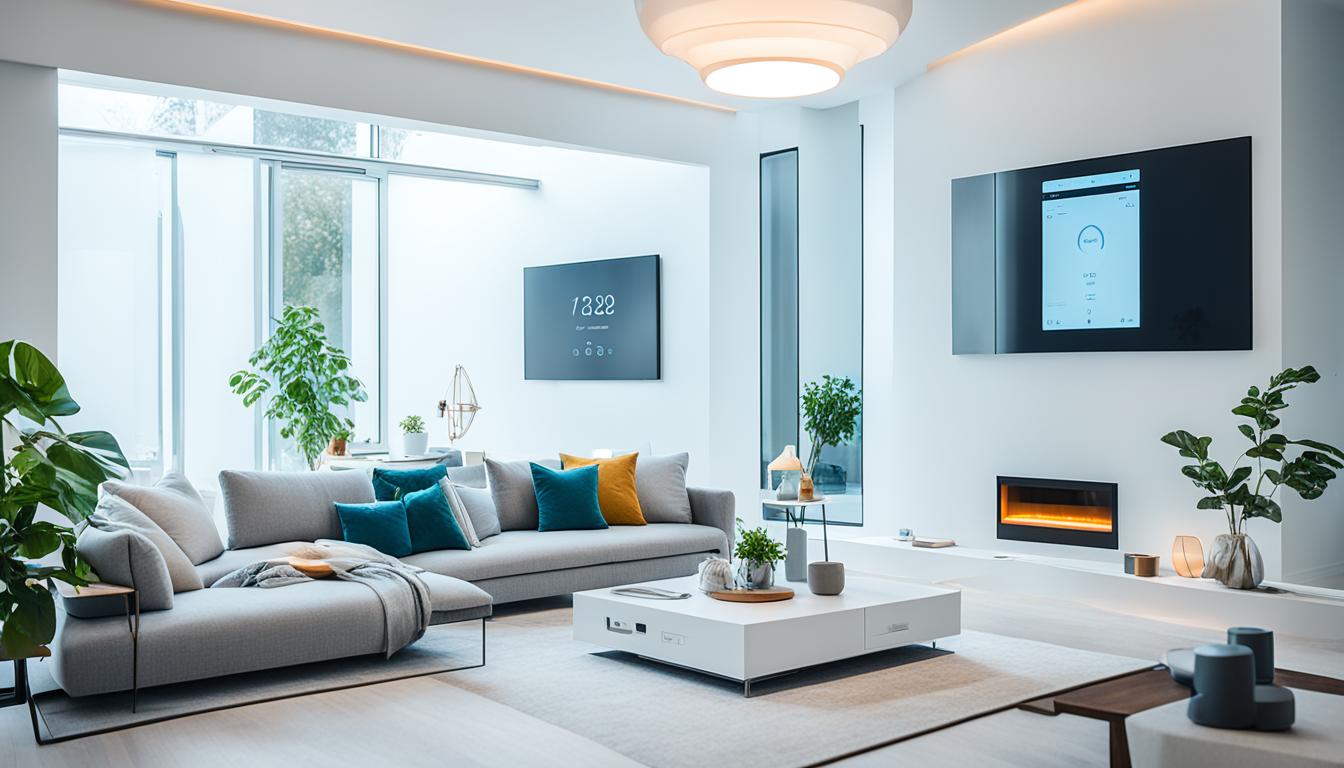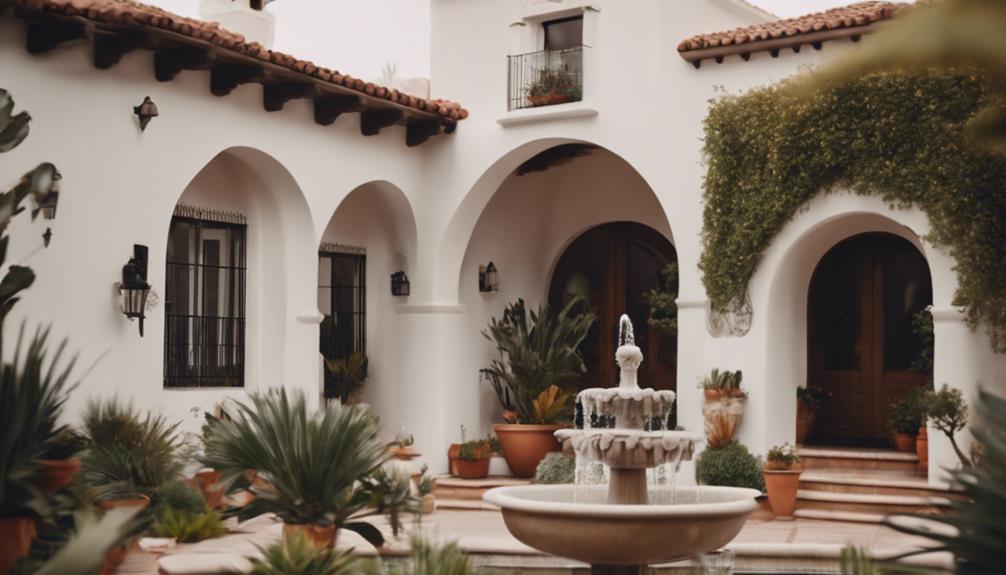During the pandemic, with the shift to remote work, many converted their homes into workspaces, resulting in a rapid rearrangement of living spaces. Some sought inspiration from celebrities to make their work-from-home setup more sophisticated. Celebrity workspace inspiration
Consider Emma Roberts’s “Grown-up Dollhouse” in LA. It’s a stunning example that combines style with function. With 14 slides, her home office is a creative and professional haven. These celebrity home office tours give great tips for working from home. They turn simple spots into stylish productivity zones.
Fans exploring these celebrity spaces find practical home office design ideas. From Sofía Vergara’s breezy LA paradise to Amber Valletta’s eco-friendly space, the inspiration is vast. The challenge is to make these luxurious ideas work for your home office in a practical way.
Key Takeaways
- Celebrity home office tours provide a wealth of design inspiration.
- Remote work has redefined personal spaces for productivity.
- Emma Roberts’s office is a great example of style meeting function.
- Transforming home spaces into workspaces can enhance productivity.
- Drawing ideas from iconic celebrity workspaces can lead to unique designs.
The Rise of Remote Work Among Celebrities
The pandemic changed how we work, especially for celebrities. They started working from home and shared their experiences online. This made them more relatable and showed the ups and downs of remote work.
Now, 14% of people in the US work from home full-time. About 28% have a hybrid schedule. Celebrities’ home offices have inspired many to upgrade their own spaces. This led to more people wanting a nice yet practical work area at home.
Moving to remote work affected mental health, with 35% of people feeling worse. A healthy balance between work and life became hard for almost 70% of Americans. It was clear: a good home office is crucial.
Because people worked from home, there was less need for office buildings. In New York City, the amount of office space used dropped drastically during the lockdown. It has since only recovered to about half of what it was.
Celebrities have shown that how you set up your work space matters. They’ve influenced many to design better work areas at home. This shift aims to boost creativity and wellness.
Exploring Chic Home Office Spaces of Celebrities
Celebrity home offices let us peek into famous peoples’ styles. Each office shows off what the star likes. It mixes things that spark creativity and help them work. Spaces like Reese Witherspoon’s and Cindy Crawford’s are not just for work. They also inspire us.
Reese Witherspoon’s Minimalist Design
The Reese Witherspoon office shines with simplicity. It mixes white and gold for a calming space. A colorful chair and tidy bookshelves make it peaceful yet ordered. It’s clear she loves keeping things simple. This makes her office not only nice to look at but great for work too.
Cindy Crawford’s Two Distinct Workspaces
Cindy Crawford’s office has a bold look with two different styles. One side has a classic feel with dark wood and a comfy chair. The other side is light and open with a glass desk. This mix shows how versatile and stylish a workspace can be. It meets all kinds of needs and looks good doing it.

Inspiration from Mindy Kaling’s Stunning Bookshelves
Mindy Kaling’s home office in Los Angeles is a blast of vibrant colors. These colors boost creativity and show off her unique personality. The eye-catching, floor-to-ceiling bookshelves are painted a beautiful sky blue.
They invite inspiration and comfort. This shows how colorful home office ideas can work. It also shows the power of bookshelves in making a place both useful and beautiful.
Creating a Colorful Focal Point in Your Home Office
Mindy Kaling’s workspace is full of bright, bold colors. It proves how color can change a room. This stunning design doesn’t just make the office look better.
It also gives inspiration to others. A wooden desk and chair are there too. They let the color stand out while the work area stays useful.
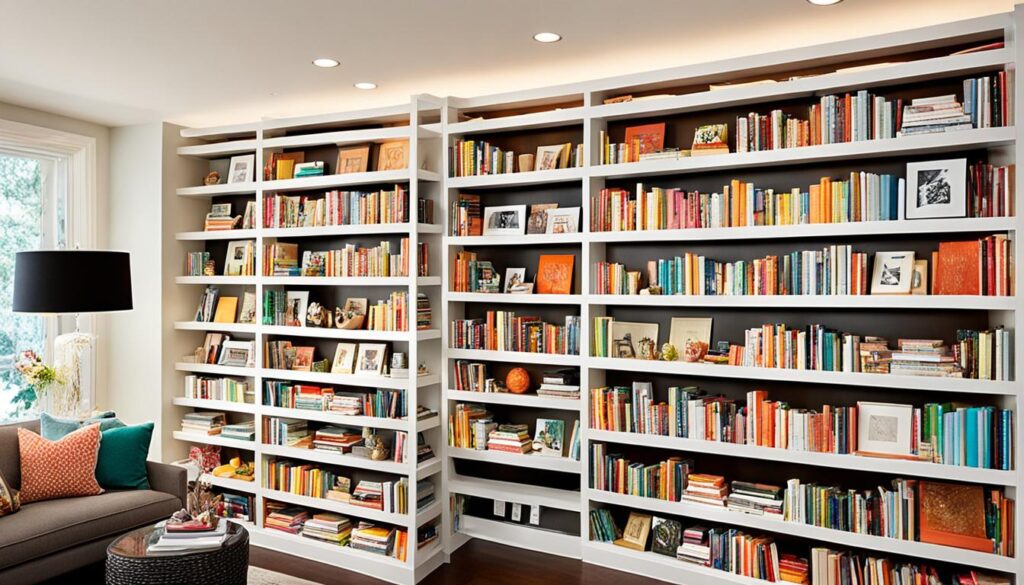
| Element | Description |
|---|---|
| Bookshelves | Floor-to-ceiling, painted sky blue for a vibrant touch |
| Color Scheme | Bright and saturated colors across the workspace |
| Desk | Wooden desk positioned to complement bookshelf colors |
| Design Inspiration | Encourages colorful home office ideas |
| Workspace Functionality | Combines aesthetics with practical office needs |
Maximalist Designs: Sophia Bush’s Creative Workspace
Sophia Bush’s office shows how a workspace can be bold and personal. It features a vintage Knoll desk and lots of art that tells her story. This setup blends personal items, creating a space full of creativity.
Embracing Art and Personal Mementos
Adding personal art to an office can turn it into an inspiration spot. Sophia uses corkboard walls for art and memories. This makes the room beautiful and stirs happy memories, boosting creativity.

Maximalist design lets you make a space filled with things that mean a lot. Here’s how to make your workspace special:
- Incorporate colorful artworks that resonate personally.
- Use unique furniture pieces that tell a story.
- Arrange personal mementos in an artistic layout to inspire daily work.
Creating a space like Sophia Bush’s boosts creativity and self-expression. Mixing art and personal touches makes any workspace uniquely yours.
Stylish Decor: Whitney Port’s Gallery Wall Ideas
Whitney Port’s home office is eye-catching, thanks to her gallery wall. It’s at the heart of her work area, making the space look better. This decor touch is not just pretty. It also shows off Whitney’s tastes, making her office feel welcoming and full of inspiration.
How to Incorporate Personal Style into Your Office
To make your workspace feel like it’s truly yours, take cues from Whitney Port’s gallery wall. Here are some tips for decorating your office:
- Choose Art That Resonates: Pick art that has personal meaning. It will make your space feel more special.
- Balance With Nature: Adding plants makes your office look lovely. Plus, plants can clean the air and bring vibrant life.
- Functional Aesthetics: Whitney also uses practical items that look good, like a big plant and rollable clothes racks. This helps keep the space organized and attractive.
- Mindful Layout: Plan your art layout carefully. Aim for a balanced look with different textures and styles but a cohesive color theme.
A gallery wall like Whitney Port’s can completely transform your workspace. It lets you show off your creative side and uniqueness, while keeping the office practical and beautiful.

Airy and Inviting: Zoella’s Functional Home Office
Zoella’s home office blends elegance and function beautifully. The high ceilings and chosen decor fill the space with airiness. It’s an ideal model for anyone wanting to better their workspace. This inviting style shows how small tweaks can boost creativity and ease at home.
String Lights and Unique Desk Setups
In Zoella’s office, string lights bring warmth and a playful feel. They light up the area, making creativity flow. The smart desk set-up, with two screens, stresses a workspace’s effectiveness and productivity. By wisely using these elements, you can achieve a snug yet efficient workspace too.
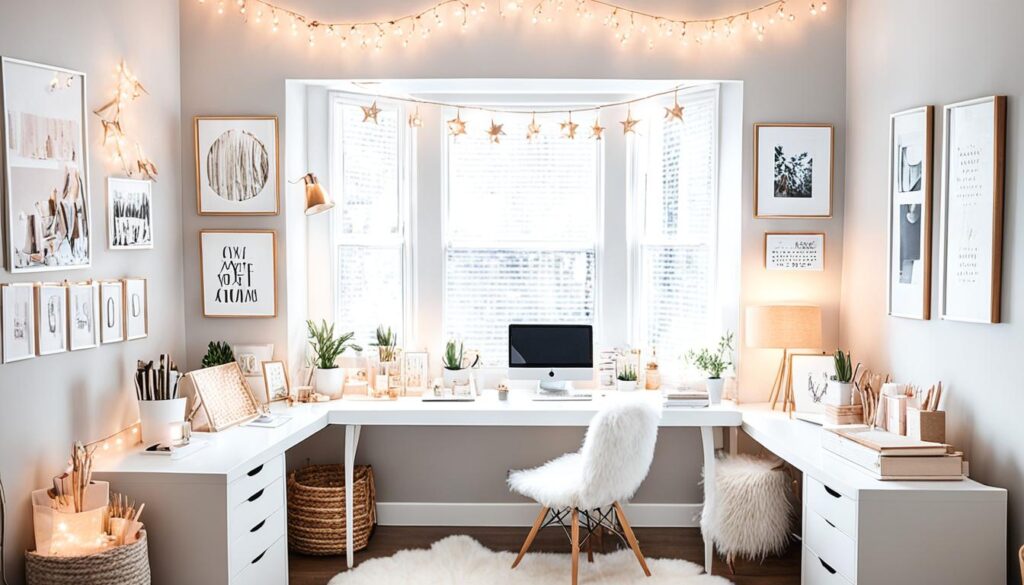
| Feature | Description | Benefits |
|---|---|---|
| Vaulted Ceilings | High ceilings enhance the feeling of openness | Promotes an airy environment that feels less confined |
| String Lights | Soft, decorative lighting | Adds warmth and enhances mood |
| Dual Computer Setup | Efficient workspace with multiple screens | Increases productivity and allows multitasking |
| Personal Decor | Displays that reflect personal style | Creates a sense of ownership and comfort in the space |
Working from Home Like the Stars: Celebrity Home Office Tours and Tips
Looking to improve your home office? Take ideas from celebrity home office tours. Stars often mix practicality with style, providing fantastic inspiration. Their offices usually have special touches that boost creativity and work efficiency.
Celebrity offices often feature wood panels, classy chairs, and beautiful wood floors. They usually have bright, naturally lit rooms that feel welcoming. Soft colors and materials like velvet are common, together with cozy fireplaces for added calm.
If you’re thinking of revamping your space, working from home tips from celebrities can help. Adding bright colors or plants can make the office livelier. Unique rugs and child-friendly workstations show how to combine fun and function, improving work flow.
Investigating celebrity workspace ideas shows a liking for industrial desks and soft colors. This mix brings a modern yet comfortable vibe. Personalizing the space with old furniture can also make it more you.

By exploring the offices of stars like Kim Kardashian and Leonardo DiCaprio, you can find inspiration to suit your style. Whether through elegant design or creating a peaceful work area, copying these celebrities might result in a productive and fashionable home office.
Creating a Relaxing Atmosphere: Tips from Celebrity Offices
A tranquil work environment boosts productivity and creativity. Many celebrities have made their home offices a place for well-being. They use natural light and add plants, creating a calm atmosphere.
A relaxing home office improves your daily tasks. It also helps your mental health and keeps you motivated.
Importance of Natural Light and Plants
Natural light is key for a good mood and high energy. It’s crucial for a comfortable home office. Sunlight can lower stress and make you more productive. That’s why celebrities often work near windows.
For home workers, a well-lit space is more welcoming and helps get more done.
Adding plants to your office makes it look and feel better. Plants like snake plants, pothos, and peace lilies are good for starters. They clean the air and don’t need much care.
These plants can grow with little light and don’t take up much of your time.
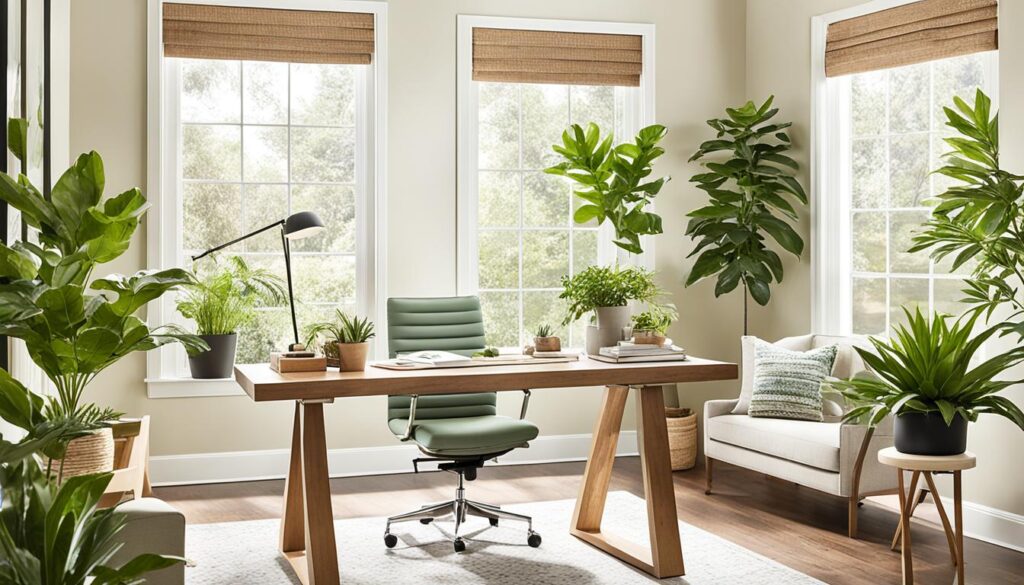
Using both natural light and plants creates a great work space. It follows the celebrity trend for a calming office. This set-up keeps you focused and comfortable while working from home.
Design Elements That Enhance Productivity
A well-designed workspace boosts work output. Smart design, like enough storage and flexible furniture, is key. Curated Nest says an open desk with storage helps keep things handy and adds a personal touch to inspire creativity.
Choosing the right office layout matters. Desk size must fit your computer, says Andrew Martin. This makes work flow better. Good lighting is also a must, adds John Cullen. It keeps you focused and enhances mood. Bright colors like blue and red can make you more alert.
Making your office feel better is crucial too. Add calming plants or colors for peace. Research shows a comfy temperature between 23 and 25 degrees Celsius keeps your mind sharp. With the right design elements, your office can be as productive as those of the stars.

